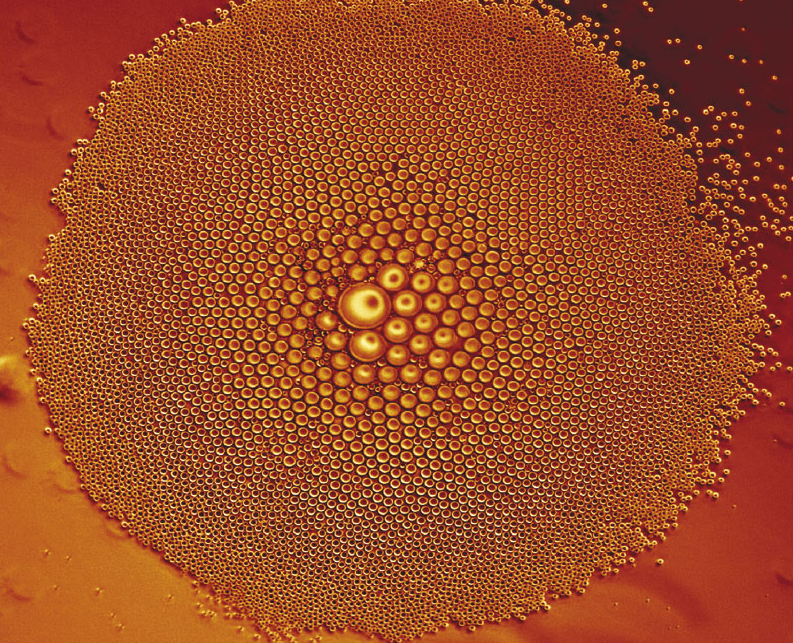
Paddy Royall started 2013 well with his group's work providing the front cover image for the first issue of the
year of 'Soft Matter', an RSC publication.
The image comes from work published in the journal, 'In search of colloidal hard spheres' and is based on a phase contrast microscopy image of emulsion droplets of dodecane in a sodium docedyl sulphate solution, by Max Meissner and C. Patrick Royall.
Soft Matter, 2013,9, 17-27
Soft matter is a subfield of condensed matter comprising a variety of physical states that are easily deformed by thermal stresses or thermal fluctuations. They include liquids, colloids, polymers, foams, gels, granular materials, and a number of biological materials.
These materials share an important common feature in that predominant physical behaviors occur at an energy scale comparable with room temperature thermal energy. At these temperatures, quantum aspects are generally unimportant.
Pierre-Gilles de Gennes, who has been called the "founding father of soft matter,"received the Nobel Prize in physics in 1991 for discovering that the order parameter from simple thermodynamic systems can be applied to the more complex cases found in soft matter, in particular, to the behaviors of liquid crystals and polymers.
Interesting behaviors arise from soft matter in ways that cannot be predicted, or are difficult to predict, directly from its atomic or molecular constituents. This is often because soft matter self-organizes into mesoscopic physical structures that are much larger than the microscopic scale (the arrangement of atoms and molecules), and yet are much smaller than the macroscopic (overall) scale of the material.
Interesting behaviors arise from soft matter in ways that cannot be predicted, or are difficult to predict, directly from its atomic or molecular constituents. This is often because soft matter self-organizes into mesoscopic physical structures that are much larger than the microscopic scale (the arrangement of atoms and molecules), and yet are much smaller than the macroscopic (overall) scale of the material.
The properties and interactions of these mesoscopic structures may determine the macroscopic behavior of the material. For example, the turbulent vortices that naturally occur within a flowing liquid are much smaller than the overall quantity of liquid and yet much larger than its individual molecules, and the emergence of these vortices control the overall flowing behavior of the material. Also, the bubbles that comprise a foam are mesoscopic because they individually consist of a vast number of molecules, and yet the foam itself consists of a great number of these bubbles, and the overall mechanical stiffness of the foam emerges from the combined interactions of the bubbles. By way of contrast, in hard condensed matter physics it is often possible to predict the overall behavior of a material because the molecules are organized into a crystalline lattice with no changes in the pattern at any mesoscopic scale.
Soft materials are important in a wide range of technological applications. They may appear as structural and packaging materials, foams and adhesives, detergents and cosmetics, paints, food additives, lubricants and fuel additives, rubber in tires, etc. In addition, a number of biological materials (blood, muscle, milk, yogurt, jello) are classifiable as soft matter.
Soft materials are important in a wide range of technological applications. They may appear as structural and packaging materials, foams and adhesives, detergents and cosmetics, paints, food additives, lubricants and fuel additives, rubber in tires, etc. In addition, a number of biological materials (blood, muscle, milk, yogurt, jello) are classifiable as soft matter.
Liquid crystals, another category of soft matter, exhibit a responsivity to electric fields that make them very important as materials in display devices (LCDs). In spite of the various forms of these materials, many of their properties have common physicochemical origins, such as a large number of internal degrees of freedom, weak interactions between structural elements, and a delicate balance between entropic and enthalpic contributions to the free energy.
These properties lead to large thermal fluctuations, a wide variety of forms, sensitivity of equilibrium structures to external conditions, macroscopic softness, and metastable states. Soft matters, such as polymers and lipids have found applications in nanotechnology as well.
The realization that soft matter contains innumerable examples of symmetry breaking, generalized elasticity, and many fluctuating degrees of freedom has re-invigorated classical fields of physics such as fluids (now generalized to non-Newtonian and structured media) and elasticity (membranes, filaments, and anisotropic networks are all important and have common aspects). Soft condensed matter is directly related to studies in biophysics. One possible roadblock to the development of biophysics as an established field is that soft condensed matter may be diverging into two distinct directions: a physical chemistry approach and a complex systems approach.
The realization that soft matter contains innumerable examples of symmetry breaking, generalized elasticity, and many fluctuating degrees of freedom has re-invigorated classical fields of physics such as fluids (now generalized to non-Newtonian and structured media) and elasticity (membranes, filaments, and anisotropic networks are all important and have common aspects). Soft condensed matter is directly related to studies in biophysics. One possible roadblock to the development of biophysics as an established field is that soft condensed matter may be diverging into two distinct directions: a physical chemistry approach and a complex systems approach.

No comments:
Post a Comment